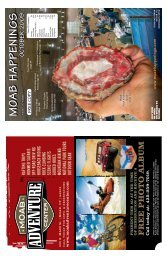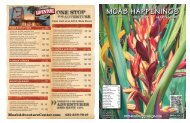Moab Happenings
Moab Happenings
Moab Happenings
Create successful ePaper yourself
Turn your PDF publications into a flip-book with our unique Google optimized e-Paper software.
6A • March 2011 • <strong>Moab</strong> <strong>Happenings</strong><br />
NATURE HAPPENINGS<br />
Early Spring Wildfl owers<br />
Early Spring Wildflowers by Damian Fagan<br />
The procession of spring flowers may start early<br />
in Canyon Country. Some years, the first flowers arise<br />
in mid-January poking their floral heads above the<br />
sandy desert floor. Other years, snow and ice slow the<br />
progression of budding blooms and the first flowers do<br />
not erupt until February or March.<br />
Most often the first flower to arise is one of<br />
the Carrot family members: the Parry’s lomatium<br />
(Lomatium parryi). Easily overlooked, the dense<br />
cluster of tiny yellow flowers are borne in an umbrellalike<br />
pattern known as an “umbel.” This arrangement<br />
provides for the family<br />
name, Umbelliferae.<br />
In a break from<br />
tradition, the Parry’s<br />
lomatium sends up these<br />
flowering heads long<br />
before the leaves appear.<br />
Arising on reddish stems,<br />
the leafless stalks range<br />
from a couple of inches<br />
high to nearly 2 feet tall.<br />
Last year’s dried leaves<br />
may still be present when<br />
the plant’s bloom.<br />
Named in honor of<br />
Charles Christopher Parry<br />
(1823-1890), he was the<br />
first official botanist of<br />
the U.S. Department of<br />
Agriculture. He joined<br />
several survey parties to<br />
the American West where<br />
he collected a number of<br />
species new to science.<br />
Another lomatium<br />
that blooms early in the<br />
year is the Canyonlands<br />
biscuitroot (Lomatium<br />
latilobum). Found growing<br />
in sandy sites in close<br />
proximity to the Entrada<br />
Sandstone, these plants only grow in several sites in<br />
the Four Corners area. The biscuitroots grow in large<br />
clumps and the highly dissected leaves are somewhat<br />
similar to those of a domesticated relative, the carrot.<br />
Named for its restricted range in the Canyonlands<br />
region, this Carrot family member also sends up<br />
clusters of tiny yellow flowers arranged in an umbel.<br />
Native Americans harvested the plant’s taproots and<br />
pulverized the roots into flour; hence, the common<br />
name. Lomatium means “fringed” and refers to the<br />
wavy edges on the seeds.<br />
Other members of the Carrot family that start<br />
blooming in early spring include members of the<br />
Cymopterus genus. There is the Fendler spring-parsley<br />
and the basin white-cup spring parsley that have yellow<br />
and whitish flowers, respectively. The highly divided<br />
www.moabhappenings.com<br />
by Damian Fagan<br />
leaves resemble those of the herb<br />
parsley, hence the reference in<br />
the common name.<br />
Like the lomatiums, these<br />
spring-parsleys also have winged<br />
fruit. Some species have papery<br />
wings on the seeds; others bear<br />
corky wavy edges.<br />
Two other plant families<br />
that are well represented with<br />
early spring wildflowers are the Mustard family<br />
(Brassicaceae) and the Pea Family (Fabaceae). Flowers<br />
in the Mustard family<br />
generally have four petals<br />
and 6 stamens. Both the<br />
petals and stamens are<br />
arranged in a cross pattern,<br />
and this arrangement<br />
derives another name for<br />
the family the Cruciferae.<br />
One of my favorite<br />
“crucifs” is spectacle-pod<br />
(Dithyrea wislizenii). Two<br />
rounded seedpods are fused<br />
together along a common<br />
midline and resemble a pair<br />
of spectacles. The species<br />
name honors Friedrich<br />
Adolph Wislizenus<br />
(1810-1889), a German<br />
immigrant who joined a<br />
trading caravan to Mexico<br />
in 1846 where he collected<br />
specimens of the local flora<br />
and fauna.<br />
The Pea family is<br />
well represented by<br />
early spring flowers. The<br />
pinkish-purple blooms<br />
of rimrock milkvetch,<br />
crescent milkvetch,<br />
Preuss’ milkvetch, woolly<br />
locoweed, and painted<br />
milkvetch. All have interesting seedpods, but those<br />
of the painted milkvetch are inflated and have reddish<br />
mottling that resembles painted pottery.<br />
Although these flowers may not be the showiest<br />
desert wildflowers compared to the cacti and<br />
globemallows that bloom later in spring, their presence<br />
marks the seasonal transition and heralds the return of<br />
spring. Long may they bloom!








